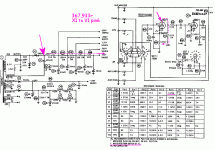Hi guys, I'm still a novice to tube amps. Good at soldering but just learning electronics. Anyway I've got this Sherwood S5000 ii that I'm rehabbing. It was in original condition and still had the original tubes. I've been going through it as much as I can measuring voltages, etc and working up a plan of what I need. I was measuring the tube socket pin resistances on the preamp section, 12ax7's and I'm running into some issues with the pin 1's and 6' on all tubes. There is a side note in the manual stating that those pins should be "measured from the output of X1" X1 is a diode coming on the transformer 160VAC. So i've tried to get resistances trying to measure it every way I can imagine. I've tired bother sides of the diode, and I've tried to ground as well but theissue I'm having is that the resistance values just keep creeping up slowly. For example tube socket V1 should show resistance of 370k on pin 1, but it just keeps going up past that and after a couple of minutes I just give up because it doesn't ever seem to stabilize. I probably let it go to 800k or so before giving up bu its clear either I'm doing something wrong or there is something wrong in the circuit. The same pattern emerges on both pin 1 and 6 on all of those tube sockets. Also, I'm not sure if tubes should be in or out and I've tried both ways. I will say most of the resistances are stable regardless of if the tubes are in or out. I'm attaching the service note which has the circuit diagram and the resistance values. Please note the circuit diagram is cut up into 3 parts and there is some overlap where they cut off the pages. I had to zip the file because it was too large to attach otherwise. Thank you.
Attachments
Tubes in or out: a cold tube is DEAD except for the heater. So poking the plate, makes no difference no-tube or cold-tube.
Look at what they want you to measure. (We only need two snips from the full manual.) Effectively from the plate to the raw DC source at X1.
If you assume no sneak-paths (normally none), then add all those resistors together. Obviously 270k, plus the 82k last dropper, plus..... my abacus came to 367,933 which is == 370k for practical purpose. There will be some charge-up in all those filter caps before it gets near 370k. However it should not be *higher*.
If you are getting this *only* on the phono preamp tubes, suspect R98 82k. Is it 82k? Or far higher? (After allowing caps to charge.) It is not a high-stress point but the amp IS not as young as it used to be, and old commercial resistors were not as good as modern ones. Also poke at it: a crack right through is a common failure mode (they are just cheap clay). If gone bad, any 1/4W or 1/2W 47k to 100k resistor should get it going fine. A jumper clip will let you test for 278k p6 to X1, or show that R99 R100 et al have also stepped off this mortal coil. (Don't power-up with tubes in until you have a >47k resistor at R98, it might motorboat.)
Look at what they want you to measure. (We only need two snips from the full manual.) Effectively from the plate to the raw DC source at X1.
If you assume no sneak-paths (normally none), then add all those resistors together. Obviously 270k, plus the 82k last dropper, plus..... my abacus came to 367,933 which is == 370k for practical purpose. There will be some charge-up in all those filter caps before it gets near 370k. However it should not be *higher*.
If you are getting this *only* on the phono preamp tubes, suspect R98 82k. Is it 82k? Or far higher? (After allowing caps to charge.) It is not a high-stress point but the amp IS not as young as it used to be, and old commercial resistors were not as good as modern ones. Also poke at it: a crack right through is a common failure mode (they are just cheap clay). If gone bad, any 1/4W or 1/2W 47k to 100k resistor should get it going fine. A jumper clip will let you test for 278k p6 to X1, or show that R99 R100 et al have also stepped off this mortal coil. (Don't power-up with tubes in until you have a >47k resistor at R98, it might motorboat.)
Attachments
Last edited:
Thank you for taking the time to respond and to write that out for me. It helps me to understand the logic behind the values they listed. Its late tonight but I'll look more closely at it tomorrow. The issues don't only happen on the phono stage but it happens with all of the 12ax7 sockets, which if my understanding is correct, leads me to believe I need to look at r100. But I'll measure 98-102 just to be sure. Thank again.
Sounds like a cap is charging, so you could just take a "snapshot" resistance reading, test leads on...100k ish .... ok, that's good enough. If your looking to see if an R has gone high unless you've found lots of high xxxk resistors elsewhere or have been getting unusual voltage readings I wouldn't worry. Valves aren't like their three legged brethren who winge and cry when there's a 0.7v disparity, a few volts (or k's of resistance) either way means nowt.
Andy.
Andy.
- Status
- This old topic is closed. If you want to reopen this topic, contact a moderator using the "Report Post" button.
